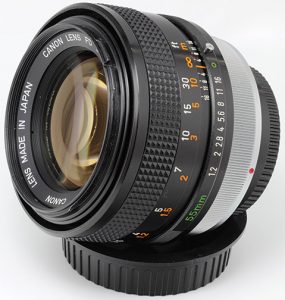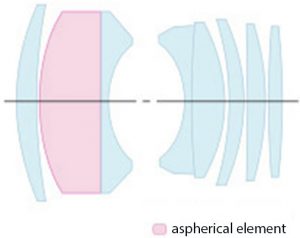
Melville, NY—This year is the 50th anniversary of the release of the Canon FD55mm f/1.2 AL. It was Canon’s first interchangeable SLR lens for its cameras that featured the first aspherical lens element.
Today, the company uses aspherical lens elements in its lenses for ILC cameras, broadcast lenses, semiconductor lithography systems, telescope mirrors as well as other optical products. Aspherical lenses possess a curvature that is ideal for gathering light at a single point. Canon’s aspherical lenses help reduce various types of aberration to provide high image quality.
The inherent characteristics of spherical lenses inhibit the lens from focusing parallel rays of light in their complete form at a single common point. Due to the lens’s spherical-shaped surface, blurring of images—spherical aberration—and other optical aberrations tend to occur in the captured image.
First Aspherical Lens Element Development
Before the advent of an aspherical lens, in order to correct spherical aberration, multiple spherical lenses were placed in a specific configuration. However, thanks to their unique properties, the same results are achieved using only a single aspherical lens.

In 1963, Canon embarked upon a program of lens research and development. The goal was to develop a “dream lens” that could focus all incident light on a single point and create a consistent, clear image.
However, in order to mass-produce aspherical lenses, Canon needed processing technology that was precise to within less than 0.1 micrometers. It also needed high-precision measuring devices that could measure to within 0.01 micrometers.
Through repeated cycles of design and processing methods, the company finally created the technology needed to mass-produce aspherical lenses. In March 1971, Canon’s first interchangeable lens for SLR cameras employing an aspherical lens was released—the FD55mm f/1.2 AL.

Then, in 1973, Canon enhanced its lens–processing technology with the development of the ALG-Z nanometer-level ultrahigh-precision aspherical lens grinder. The next leap forward happened in 1985, when the company implemented for the first time a large-diameter glass mold (GMo) aspherical lens element into the FD35–105mm f/3.5–4.5.
Canon Lens-Processing Technologies
Canon’s technological portfolio includes four aspherical lens–processing technologies. First, its aspherical lens grinding and polishing employs diamond-tipped tools to grind and polish the lens glass. Second, aspherical glass molding presses and forms the lens glass using an aspherical mold. Third, aspherical replica technology uses an aspherical mold to form aspherical resin on the surface of spherical glass. Finally, aspherical plastic molding injects and shapes resin inside an aspherical mold. Moreover, Canon will utilize the appropriate technology to produce lenses to serve the wide-ranging needs of its customers.
In addition, Canon develops its lens–processing machinery independently. To illustrate its accuracy, only 0.1 micrometers’ discrepancy is allowed between a lens’s design schematic and the finished product. That means for a lens expanded to the size of the Tokyo Dome’s roof (diameter: 244 m), there would exist a margin of error smaller than 0.5 mm; that’s the thickness of a mechanical pencil lead.
Moreover, its aspherical lens grinding and polishing technology—the most precise of the four technologies—is also used in the sciences. For example, the main camera optical correction system of the National Astronomical Observatory of Japan’s Subaru telescope features Canon aspherical lenses.
“Into the future, Canon will continue to optimize its optical technologies in order to create products and technologies that help meet our customers’ wide-ranging needs,” the company announced.





